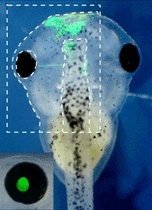by
Brendon Nafziger, DOTmed News Associate Editor | August 31, 2009
Scientists at the State University of New York Upstate Medical University in Syracuse gave new hope to those blinded by eye disease by creating artificial "eyes" in tadpoles using stem cells, according to a study published this week on PloS Biology.
"Very encouraging data, a very important step forward," says Dr. Jeffrey L. Goldberg, an ophthalmologist and neuroscientist at the Bascom Palmer Eye Institute at the University of Miami.
Diseases of the eye, specifically of the retina, the part of the eye containing rods and cones that help transform light into nerve signals, put almost 80 million Americans at risk of blindness each year, according to Bascom Palmer. Diabetics are especially vulnerable, with 14 million at risk of going blind, according to the institute.



Ad Statistics
Times Displayed: 7181
Times Visited: 166 Keep biomedical devices ready to go, so care teams can be ready to care for patients. GE HealthCare’s ReadySee™ helps overcome frustrations due to lack of network and device visibility, manual troubleshooting, and downtime.
In the study, the SUNY scientists were able to grow new "eyes" in tadpoles containing all seven major classes of retinal cells -- cells almost identical to those found in humans, raising hopes that this procedure could one day be transferred to mammals, and possibly humans, to restore sight lost from retinal disease.
The researchers at SUNY Upstate Medical University began the experiment by first harvesting so-called pluripotent cells from frog embryos -- "open-minded" cells with the capacity to become almost any kind of cell, with the right chemical instructions. The SUNY researchers turned on a protein-based code in these harvested cells, known as eye field transcription factors, which told the cells to become eye tissue. These EFTF-expressed stem cells were then grafted onto another set of frog embryos that had been blinded -- their growing eyes and optic nerve tissue had been removed.
Because frogs have the ability to regrow eye cells, the stem cells the researchers planted came from a genetically modified embryo whose cells glow fluorescent green, so there would be no mistaking them for native tissue. "If you take out half the [eye] cells, the frog will grow a new eye, it'll just be smaller," Dr. Andrea Viczian, one of the authors of the study, and a professor of ophthalmology at SUNY Upstate Medical University, tells DOTmed News. "We wanted to make sure all the [new] cells were from the transplanted cells."
Once the embryos became tadpoles, Dr. Viczian tested their new induced "eyes" using an electroretinogram, a device that measures how the eye responds to light. "The ERG looked normal," Dr. Viczian says, indicating that the tadpoles appeared to have grown a working eye. However, the real test would be observing the tadpoles' behavior. "The eye itself is functioning, but you don't know if it's connecting properly to the brain," she says.

